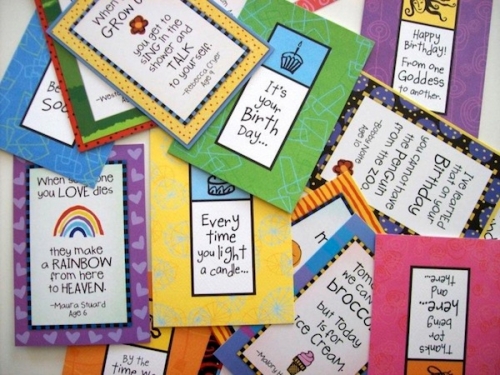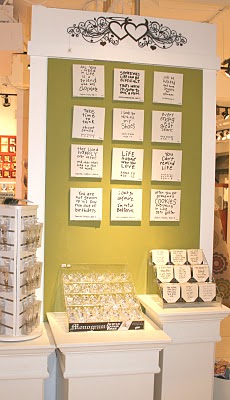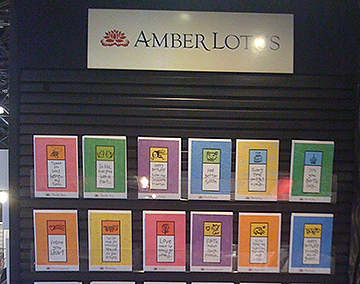By Carolyn Edlund
Card designer Kate Harper, whose popular collections have been loved and purchased by fans for many years, shares her experience and insights for other entrepreneurs.

AS: What do you first come up with as a concept for a card collection? Do you visualize the finished product, or start with an idea and move forward?
KH: I generally think of a theme first based on quotes I have available. I either make them up or purchase them from writers. For example recently I did the theme “bicycles” and thought about how that theme can relate to many sentiments, such as facing uphill challenges or following our own path.
I start by experimenting with a handful of different art styles and then show the designs to someone and get feedback on which one looks the best and communicates the message the best. After that I create an entire line around that style and theme, perhaps 12-48 images. I always try to focus on what kind of card I would buy, since I’m the target market for greeting cards (midlife, female).
AS: What would you say are the most important factors you take into account to maximize the saleability of a card line?
KH: To me, selling cards directly to stores (what I used to manufacture for 15 years) and selling designs to companies are two different markets. When I published my own cards, I often tried edgier quotes and themes and they sold well, whereas larger companies tend to want things toned down a bit. Therefore, if you are “selling designs” to a card to a company, you probably need to appeal to a wider range of the population.
For example, recently a card designer I know, Marie Snyder of February Stars created several cards to congratulate a gay couple on their marriage. I’m convinced these cards will be hot sellers, especially in hip urban areas. Luckily she is selling directly to retail stores. I’m not sure if a company would be quick to license these since they might be concerned they are a political statement some parts of the country don’t agree with. Since she publishes her own cards, she has the benefit of getting them out on her own, into the marketplace immediately after the Supreme Court decision.
AS: You license your card designs to manufacturers. What is the process of working with the manufacturer to change and hone your designs into the final product?
KH: I usually offer a set of cards on a theme. Sometimes they ask for adjustments, but not very often. And if they do, it is usually something very simple like changing a color or background pattern. Once I learned Photoshop, my art life became really easy. Even though all my art and fonts are originally hand drawn, I do all my colors with Photoshop.
AS: Do you have a favorite card line that you’ve created?
KH: Yes, but that was about 20 years ago. They were my very first card line, but a little introspective and deep. Based on ancient Buddhist quotations and symbolism, they were popular because the “New Age” bookstores were doing really well.
AS: What mistakes in designing a line would you warn other artists to avoid?
KH: I think the most common one I see with card designers is they forget that a card needs to communicate a “message” that is given from one person to another. Cards are very different than other products in this way.
Cards often involve a relationship between two people privately. Usually there is a recipient in mind when a card is purchased, whereas gifts are often intended for the purchaser. For example, buying a birthday card for your brother is a very specific, personal item you will give to him. On the other hand, buying a magnet could be something you want to own and display for yourself and for everyone to see.
AS: Your card collections, when presented on a display, make a much bigger impression than just one card. What factors do you take into account to make the most impact?
KH: I believe the colors of the line have to match in order for the customer to be drawn towards the rack. After that, the message is important and will be the ultimate purchasing decision.
AS: Do you have any new collections on the horizon?
KH: I am working on my roots when I started my card business in the late 1980’s. I want to try to get into spiritual themes again. This was encouraged by two dear friends from those old days. Let’s see what happens!




Gracias por compartir su experiencia, yo en estos momentos estoy terminando mis tarjetas, las primeras , así que estoy deseando saber como será el mercado para mi producto.
Muchas gracias.
María Gina
Thank you for your advice. I was hoping to sell greeting cards made from my paintings. I made one for our parish of the church we hope to build. They sold very well. I have not sold any from Fine Art America. Do you have any suggestions?
Lucille,
There are many other articles on greeting card lines on this blog. Check out this link for more: http://www.artsyshark.com/category/greeting-cards/
Loved the interview and insightful help. I made a huge mistake with one of my card lines that I loved, but pulled from stores after realizing a MAIN MISTAKE I made. They were not from ONE PERSON TO ANOTHER, they were more group oriented (“we”, from “us” cards). Kate mentions this, and I’d like to re-emphasize it. Groups don’t buy as many single cards to someone, more are bought from one person to another! I loved the card line I made and all the characters, but I’ve had to put them on the back shelf for the day I pull them out for a makeover.
Cheri, Yes, that definitely is a common mistake – among others. Anything that is too specific or limiting in a greeting will cause sales to tank. I often counsel clients to avoid cards directed to relatives, or narrow categories like Divorce, I’m Sorry, Pet Sympathy, etc. which will not produce, just as you experienced with your “group cards”
Carolyn
That is really true that cards often involve a relationship between two people. It would be good to find a good greeting card for something that I cared about a lot. Having a hand-drawn card would be something that I would like to have.